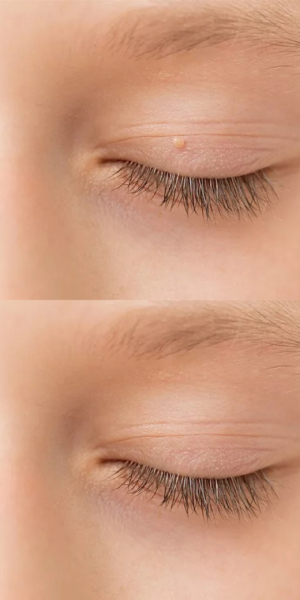Minor cosmetic surgery
A number of procedures are available under local anaesthetic:-
Removal of skin tags, warts and cosmetic blemishes by a professional doctor
Dr Rosalind Mole BMBS MRCS MRCGP is a highly skilled GP and dermatology specialty doctor serving the Plymouth community. With memberships to both the Royal College of General Practitioners and the Royal College of Surgeons, Dr Mole brings a wealth of expertise to her practice.
Her medical journey began in the South West, followed by foundation training at Derriford Hospital. She then pursued Core Surgical Training in Salisbury and Dorchester, focusing on Plastic Surgery, before returning to Plymouth as a Plastic Surgery registrar. Dr. Mole’s training extends globally, with medical electives in London, South Africa, and microsurgical training in India.
While her background encompasses various surgical disciplines including general, breast, ENT, and orthopaedic surgery, Dr Mole transitioned to a career in general practice to achieve a better work-life balance while continuing to provide surgical skin cancer care and general dermatology services. Her meticulous attention to detail, honed through her surgical experience, ensures optimal cosmetic outcomes with minimal scarring.
Dr Mole’s compassionate and approachable demeanour fosters trust and comfort among her patients, establishing strong doctor-patient relationships essential for comprehensive care. Whether addressing skin cancer cases requiring reconstruction or cosmetic skin surgery, Dr Mole’s dedication to perfection and patient satisfaction shines through in every procedure


MOLE REMOVAL
Moles, or benign naevi, are harmless pigmented lesions within the skin. They vary in colour but are usually smooth and round in shape. Most moles develop in the first 30 years of life. Although harmless, some moles can be in awkward places and cause problems such as irritation and catching on clothing, others may be in a place that an individual finds unsightly. If this is the case, at Erme clinic, we can remove these lesions for you. The specific technique used varies according to the lesion in question and a thorough assessment will be made before a treatment plan is decided. The mole can then be sent to the laboratory for assessment if considered appropriate.
SPIDER VEINS AND THREAD VEINS
It is possible to improve and sometimes remove completely those unsightly, wiggly pink, tiny surface veins using a process called hyfrecation or radiofrequency ablation. This type of problem commonly occurs on the face or legs. This involves passing a very low voltage electric current or low fluence radiofrequency to the exact point where these veins are which desiccates them (fries them up!). People usually find this causes only minor discomfort, no worse than waxing, for example. Local anaesthetic cream can be used if necessary before this is done. Dr Elsey will advise you whether your condition is suitable for this treatment. Some cases are not suitable and would be better treated by another means and I can refer you.Hyfrecation/ Radiofrequency treatment does not work for the blue/black thread vein
SEBORRHOEIC KERATOSIS REMOVAL
Seborrhoeic keratoses are benign, usually pigmented lesions which have a stuck on appearance on the skin. They vary in shape and size. Most people will have one somewhere and some people have many of these lesions. As they are pigmented lesions that can be irregular in shape and colour they can cause concern and can sometimes be mistaken for melanoma. If, when reviewed in clinic, there was any indication of a more sinister lesion you would be signposted into the NHS for further assessment. However, most seborrhoeic keratoses can be positive diagnosed by trained clinicians. These lesions can often be treated with shave excision as they are raised from the skin. In some cases, a more formal excision would be recommended. The lesion can be sent to the laboratory for assessment if considered appropriate.
SKIN TAGS AND WARTS
These lesions usually stick up from the skin and can be unsightly or irritating. In most cases they can easily be removed as a shave excision. This involves an injection of local anaesthetic to numb the area and then the lesion is picked up from the skin and a flat shave excision is performed. The bleeding is controlled with cautery to the area and a small dressing is then applied.
SEBACEOUS CYCTS
Sebaceous cysts are sacs beneath the skin that contain a thick yellowy substance. They often have a visible punctum or hole that connect to the surface of the skin. Due to this connection, they can sometimes become infected and required antibiotics. This is a something that can be managed within the NHS. However, most cysts, are relatively non-problematic but can be unsightly or just annoying. Cysts can be removed under local anaesthetic. The aim of treatment would be to completely remove the sac that contains the contents to reduce the chance of recurrence.
LIPOMA REMOVAL
Lipomas are fatty lumps that are smooth and round in texture and within the fat beneath the skin. They are harmless but can slowly increase in size over time and sometimes be in areas which cause discomfort. They are mostly not visible to others unless large. Lumps that are rapidly growing or very painful sometimes need further assessment with ultrasound which can be arranged through the NHS and if Dr Mole felt this would be appropriate, she would direct you to your GP. Otherwise, most lipomas can be removed under local anaesthetic at Erme clinic.
REMOVAL OF FATTY STREAKS
People can have yellow, fatty streaks on their upper eyelids. Sometimes raised lipids or cholesterol is part of the cause and a blood test for this with their GP is advisable. The streaks themselves can be a cosmetic problem which bothers some individuals. These can easily be removed after an injection of local anaesthetic to numb the area. Some bruising and swelling are to be expected in the next few days after the procedure as with any procedure around the eye.
